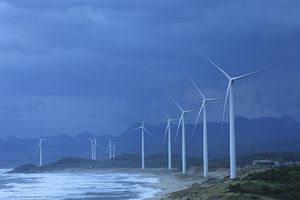A potential conflict is brewing surrounding the government’s feed-in tariff scheme for renewable energy sources like solar and wind. Japan’s major utility companies are balking at the government program, which gives companies that provide these energy sources to utilities the right to charge artificially high prices. This is done as an incentive for them to develop new and larger projects that could help to partially wean Japan from its dependence on fossil fuels, now that its nuclear industry is offline and not expected to return to its former strength.
After Kyushu Electric Power Co announced last Thursday that it would limit renewable energy providers’ access to its grid, four more utilities serving the regions of Hokkaido, Tohoku, Shikoku and Okinawa followed suit on Tuesday, bringing the total to seven of the country’s ten major utilities that now limit access. The energy providers cite the overcapacity of renewables as a potential for blackout, referring to the possibility that renewable energy could overload their grids. This problem stems from the fact that renewables are not a reliable or constant source of power, and sudden dips or spikes in energy could stress the grids, potentially leading to damage and power loss.
The government is seeking to address the problem, as it has already made renewable energy a key component of its post-nuclear dependence energy model. However, it is doing so in a roundabout fashion; not by improving grid efficiency or usage monitoring, which could limit the risks cited by the utilities, but by reviewing the fixed-price system applied to the feed-in tariff. Currently, the price utilities are required to pay when purchasing renewable energy is set when a new energy project receives government approval. The Yomiuri Shimbun reported on Wednesday that the government is now considering changing the policy so that the price is fixed when the new project actually begins operation. This could potentially limit the number of applications the utilities receive from energy providers for renewable energy sources, as those providers would likely curtail projects whose profitability would be questionable at a later date, without a fixed figure for profit before breaking ground.
However, the larger problem for Japan is to figure out how to accommodate its surging influx of renewable capacity into its existing grid. Reuters reported last week that although Japan’s utilities have “received approval for 71 gigawatts of capacity under the scheme as of April 30… only 9.8 gigawatts, of government-approved renewable capacity, or 14 percent, had been connected by the end of April.” If all of Japan’s proposed solar projects were brought online, it would almost double Germany’s capacity of 35.7 gigawatts at the end of last year, which is the current global leader.
Newer and bigger projects are also slated to begin quickly. A joint project between eight major Japanese companies will bring the country’s biggest hybrid power plant online Wednesday. Providing a mix of solar and wind energy, the plant in Tahara, Aichi prefecture will generate enough energy for 19,000 households a year (67,500 MWh/year), enough to provide 90 percent of the energy requirements for Tahara’s households, according to the Asahi Shimbun. Changing the structure of how renewable energy providers lock into prices with utilities may slow the pace of future projects, but it will not address the need to build a national grid that is better able to cope with a larger percentage of energy sources that, while clean, pose significant storage and distribution challenges.

































